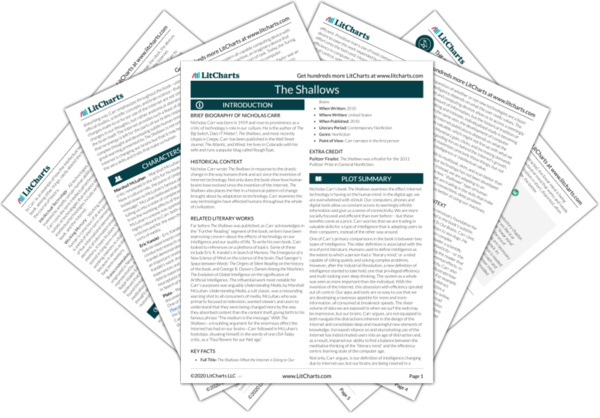Scientific context is the necessary foundation for the hypothesis embedded in the book’s subtitle, What The Internet Is Doing To Our Brains. Carr cites studies involving everything from monkeys to sea slugs. He quotes scientific experts and breaks down complex neuroscience for the layman. Giving the reader a scientific understanding of brain concepts like neuroplasticity––or the brain’s ability to change––is vital to convincing the reader that repeated use of the Internet can have lasting mental effects. In addition to explaining concepts like neuroplasticity, Carr also gives anecdotal accounts of scientific studies to illustrate how the brain performs under different circumstances. For example, to support his claim that the Internet’s interface can detract from our ability to solve more complex problems, he cites a study in which two groups of students read a short story online, one with hypertext and one without. The students who read the story without hypertext displayed deeper comprehension of the story’s content. Constantly returning to the touchstone of science with thorough citations and quotes from respected experts in a wide variety of fields gives The Shallows the authority and substance that a book of mere opinionating would lack.
Scientific Context ThemeTracker

Scientific Context Quotes in The Shallows
Calm, focused, undistracted, the linear mind is being pushed aside by a new kind of mind that wants and needs to take in and dole out information in short, disjointed, often overlapping bursts––the faster, the better.
When it came to the brain, the child was indeed, as Wordsworth had written, the father to the man.
The genius of our brain’s construction is not that it contains a lot of hardwiring but that it doesn’t.
Plastic does not mean elastic.
Although the use of any kind of tool can influence our thoughts and perspectives––the plow changed the outlook of the farmer, the microscope opened new worlds of mental exploration for the scientist––it is our intellectual technologies that have the greatest and most lasting power over what and how we think.
Sometimes our tools do what we tell them to do. Other times, we adapt ourselves to our tools’ requirements.
To read a book was to practice an unnatural process of thought, one that demanded sustained, unbroken attention to a single, static object. It required readers to place themselves at what T.S. Eliot, in Four Quartets, would call “the still point of the turning world.”
The words in books didn’t just strengthen people’s ability to think abstractly; they enriched people’s experience of the physical world, the world outside the book.
As the psychotherapist Michael Hausauer notes, teens and other young adults have a “terrific interest in knowing what’s going on in the lives of their peers, coupled with a terrific anxiety about being out of the loop.” If they stop sending messages, they risk becoming invisible.
When it comes to the firing of our neurons, it’s a mistake to assume that more is better.
The Web’s connections are not our connections––and no matter how many hours we spend searching and surfing, they will never become our connections. When we outsource our memory to a machine, we also outsource a very important part of our intellect and even our identity.
















